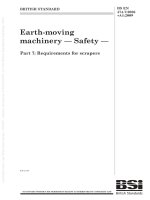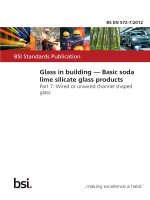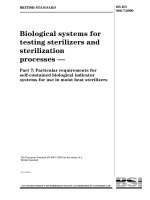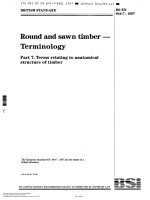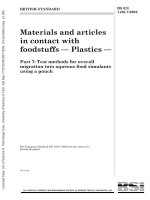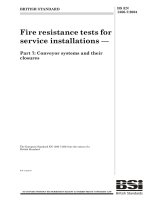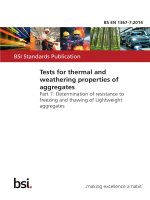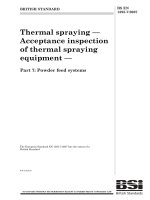Bsi bs en 61800 7 302 2016
Bạn đang xem bản rút gọn của tài liệu. Xem và tải ngay bản đầy đủ của tài liệu tại đây (1.7 MB, 38 trang )
BS EN 61800-7-302:2016
BSI Standards Publication
Adjustable speed electrical
power drive systems
Part 7-302: Generic interface and use of
profiles for power drive systems — Mapping
of profile type 2 to network technologies
BRITISH STANDARD
BS EN 61800-7-302:2016
National foreword
This British Standard is the UK implementation of EN 61800-7-302:2016. It
is identical to IEC 61800-7-302:2015. It supersedes BS EN 61800-7-302:2008,
which will be withdrawn on 12 October 2018.
The UK participation in its preparation was entrusted to Technical
Committee PEL/22, Power electronics.
A list of organizations represented on this committee can be obtained on
request to its secretary.
This publication does not purport to include all the necessary provisions of
a contract. Users are responsible for its correct application.
© The British Standards Institution 2016.
Published by BSI Standards Limited 2016
ISBN 978 0 580 82133 2
ICS 29.200; 35.100.05
Compliance with a British Standard cannot confer immunity from
legal obligations.
This British Standard was published under the authority of the
Standards Policy and Strategy Committee on 29 February 2016.
Amendments/corrigenda issued since publication
Date
Text affected
BS EN 61800-7-302:2016
EUROPEAN STANDARD
EN 61800-7-302
NORME EUROPÉENNE
EUROPÄISCHE NORM
February 2016
ICS 29.200; 35.100.05
Supersedes EN 61800-7-302:2008
English Version
Adjustable speed electrical power drive systems Part 7-302: Generic interface and use of profiles for power drive
systems - Mapping of profile type 2 to network technologies
(IEC 61800-7-302:2015)
Entrnements électriques de puissance à vitesse variable Partie 7-302: Interface générique et utilisation de profils
pour les entrnements électriques de puissance - Mise en
correspondance du profil de type 2 avec les technologies
de réseaux
(IEC 61800-7-302:2015)
Elektrische Leistungsantriebssysteme mit einstellbarer
Drehzahl - Teil 7-302: Generisches Interface und Nutzung
von Profilen für Leistungsantriebssysteme (PDS) Abbildung von Profil-Typ 2 auf Netzwerktechnologien
(IEC 61800-7-302:2015)
This European Standard was approved by CENELEC on 2015-12-25. CENELEC members are bound to comply with the CEN/CENELEC
Internal Regulations which stipulate the conditions for giving this European Standard the status of a national standard without any alteration.
Up-to-date lists and bibliographical references concerning such national standards may be obtained on application to the CEN-CENELEC
Management Centre or to any CENELEC member.
This European Standard exists in three official versions (English, French, German). A version in any other language made by translation
under the responsibility of a CENELEC member into its own language and notified to the CEN-CENELEC Management Centre has the
same status as the official versions.
CENELEC members are the national electrotechnical committees of Austria, Belgium, Bulgaria, Croatia, Cyprus, the Czech Republic,
Denmark, Estonia, Finland, Former Yugoslav Republic of Macedonia, France, Germany, Greece, Hungary, Iceland, Ireland, Italy, Latvia,
Lithuania, Luxembourg, Malta, the Netherlands, Norway, Poland, Portugal, Romania, Slovakia, Slovenia, Spain, Sweden, Switzerland,
Turkey and the United Kingdom.
European Committee for Electrotechnical Standardization
Comité Européen de Normalisation Electrotechnique
Europäisches Komitee für Elektrotechnische Normung
CEN-CENELEC Management Centre: Avenue Marnix 17, B-1000 Brussels
© 2016 CENELEC All rights of exploitation in any form and by any means reserved worldwide for CENELEC Members.
Ref. No. EN 61800-7-302:2016 E
BS EN 61800-7-302:2016
EN 61800-7-302:2016
European foreword
The text of document 22G/312/FDIS, future edition 2 of IEC 61800-7-302, prepared by
SC 22G “Adjustable speed electric drive systems incorporating semiconductor power converters” of
IEC/TC 22 “Power electronic systems and equipment" was submitted to the IEC-CENELEC parallel
vote and approved by CENELEC as EN 61800-7-302:2016.
The following dates are fixed:
•
latest date by which the document has to be
implemented at national level by
publication of an identical national
standard or by endorsement
(dop)
2016-09-25
•
latest date by which the national
standards conflicting with the
document have to be withdrawn
(dow)
2018-12-25
This document supersedes EN 61800-7-302:2008.
Attention is drawn to the possibility that some of the elements of this document may be the subject of
patent rights. CENELEC [and/or CEN] shall not be held responsible for identifying any or all such
patent rights.
Endorsement notice
The text of the International Standard IEC 61800-7-302:2015 was approved by CENELEC as a
European Standard without any modification.
In the official version, for Bibliography, the following notes have to be added for the standards indicated:
1)
2
IEC 61158-2:2014
NOTE
Harmonized as EN 61158-2:2014 (not modified).
IEC 61158-3-2:2014
NOTE
Harmonized as EN 61158-3-2:2014 (not modified).
IEC 61499-1:2005
NOTE
Harmonized as EN 61499-1:2005
IEC 61784-1:2014
NOTE
Harmonized as EN 61784-1:2014 (not modified).
IEC 61784-2:2014
NOTE
Harmonized as EN 61784-2:2014 (not modified).
IEC 61800 Series
NOTE
Harmonized as EN 61800 Series.
IEC 61800-7 Series
NOTE
Harmonized as EN 61800-7 Series.
IEC 61800-7-1:2015
NOTE
Harmonized as EN 61800-7-1:2016 (not modified).
IEC 61800-7-201
NOTE
Harmonized as EN 61800-7-201.
IEC 61800-7-203
NOTE
Harmonized as EN 61800-7-203.
IEC 61800-7-204
NOTE
Harmonized as EN 61800-7-204.
IEC 61800-7-301
NOTE
Harmonized as EN 61800-7-301.
IEC 61800-7-303
NOTE
Harmonized as EN 61800-7-303.
IEC 61800-7-304
NOTE
Harmonized as EN 61800-7-304.
IEC 62026-3
NOTE
Harmonized as EN 62026-3.
Superseded by EN 61499-1:2013 (IEC 61499-1:2012).
1)
(not modified).
BS EN 61800-7-302:2016
EN 61800-7-302:2016
Annex ZA
(normative)
Normative references to international publications
with their corresponding European publications
The following documents, in whole or in part, are normatively referenced in this document and are
indispensable for its application. For dated references, only the edition cited applies. For undated
references, the latest edition of the referenced document (including any amendments) applies.
NOTE 1 When an International Publication has been modified by common modifications, indicated by (mod), the relevant
EN/HD applies.
NOTE 2 Up-to-date information on the latest versions of the European Standards listed in this annex is available here:
www.cenelec.eu
Publication
Year
Title
EN/HD
Year
IEC 61158-4-2
2014
Industrial communication networks Fieldbus specifications Part 4-2: Data-link layer protocol
specification - Type 2 elements
EN 61158-4-2
2014
IEC 61158-5-2
2014
Industrial communication networks EN 61158-5-2
Fieldbus specifications Part 5-2: Application layer service definition
- Type 2 elements
2014
IEC 61158-6-2
2014
Industrial communication networks Fieldbus specifications Part 6-2: Application layer protocol
specification - Type 2 elements
EN 61158-6-2
2014
IEC 61588
2009
Precision clock synchronization protocol
for networked measurement and control
systems
-
-
IEC 61800-7-202
-
Adjustable speed electrical power drive
systems Part 7-202: Generic interface and use of
profiles for power drive systems - Profile
type 2 specification
EN 61800-7-202
-
3
–2–
BS EN 61800-7-302:2016
IEC 61800-7-302:2015 © IEC 2015
CONTENTS
FOREWORD ........................................................................................................................... 4
INTRODUCTION ..................................................................................................................... 6
0.1 General ........................................................................................................................... 6
0.2 Patent declaration ........................................................................................................... 9
1
Scope ............................................................................................................................ 11
2
Normative references .................................................................................................... 11
3
Terms, definitions and abbreviated terms ...................................................................... 11
3.1
Terms and definitions ............................................................................................ 11
3.2
Abbreviated terms ................................................................................................. 18
4
Principles for mapping CIP Motion™ .............................................................................. 19
4.1
General principles for mapping CIP Motion™ ........................................................ 19
4.2
Mapping CIP Motion™ .......................................................................................... 20
4.3
Data types ............................................................................................................ 20
4.4
I/O connection interface ........................................................................................ 21
4.4.1
General ......................................................................................................... 21
4.4.2
I/O Connection Formats ................................................................................. 21
4.4.3
Fixed I/O Connection Format ......................................................................... 22
4.4.4
Variable I/O Connection Format ..................................................................... 23
5
Mapping to DeviceNet™ ................................................................................................ 26
5.1
Adaptation of the device model ............................................................................. 26
5.2
Use of I/O data formats ......................................................................................... 27
6
Mapping to ControlNet™ ............................................................................................... 27
6.1
Adaptation of the device model ............................................................................. 27
6.2
Use of I/O data formats ......................................................................................... 29
7
Mapping to EtherNet/IP™ .............................................................................................. 29
7.1
Adaptation of the device model ............................................................................. 29
7.2
Use of I/O data formats ......................................................................................... 30
Bibliography .......................................................................................................................... 31
Figure 1 – Structure of IEC 61800-7 ........................................................................................ 9
Figure 2 – Overview of CIP-based networks .......................................................................... 19
Figure 3 – Connection Header .............................................................................................. 21
Figure 4 – Connection Format ............................................................................................... 21
Figure 5 – Fixed Controller to Device I/O Connection Format (fixed size = 16 bytes)............. 23
Figure 6 – Fixed Device to Controller I/O Connection Format (fixed size = 16 bytes)............. 23
Figure 7 – Controller-to-Device I/O Connection Format (variable size) .................................. 24
Figure 8 – Device-to-Controller I/O Connection Format (variable size) .................................. 25
Figure 9 – Object Model for a CIP Motion device on DeviceNet ............................................. 26
Figure 10 – Object Model for a CIP Motion device on ControlNet .......................................... 28
Figure 11 – Object Model for a CIP Motion device on EtherNet/IP ......................................... 29
Table 1 – Data types ............................................................................................................. 21
Table 2 – Object classes for a CIP Motion device type on DeviceNet .................................... 27
BS EN 61800-7-302:2016
IEC 61800-7-302:2015 © IEC 2015
–3–
Table 3 – Object classes for a CIP Motion device type on ControlNet ................................... 28
Table 4 – Object classes for a CIP Motion device type on EtherNet/IP .................................. 30
–4–
BS EN 61800-7-302:2016
IEC 61800-7-302:2015 © IEC 2015
INTERNATIONAL ELECTROTECHNICAL COMMISSION
____________
ADJUSTABLE SPEED ELECTRICAL POWER DRIVE SYSTEMS –
Part 7-302: Generic interface and use of profiles for power
drive systems – Mapping of profile type 2 to network technologies
FOREWORD
1) The International Electrotechnical Commission (IEC) is a worldwide organization for standardization comprising
all national electrotechnical committees (IEC National Committees). The object of IEC is to promote
international co-operation on all questions concerning standardization in the electrical and electronic fields. To
this end and in addition to other activities, IEC publishes International Standards, Technical Specifications,
Technical Reports, Publicly Available Specifications (PAS) and Guides (hereafter referred to as “IEC
Publication(s)”). Their preparation is entrusted to technical committees; any IEC National Committee interested
in the subject dealt with may participate in this preparatory work. International, governmental and nongovernmental organizations liaising with the IEC also participate in this preparation. IEC collaborates closely
with the International Organization for Standardization (ISO) in accordance with conditions determined by
agreement between the two organizations.
2) The formal decisions or agreements of IEC on technical matters express, as nearly as possible, an international
consensus of opinion on the relevant subjects since each technical committee has representation from all
interested IEC National Committees.
3) IEC Publications have the form of recommendations for international use and are accepted by IEC National
Committees in that sense. While all reasonable efforts are made to ensure that the technical content of IEC
Publications is accurate, IEC cannot be held responsible for the way in which they are used or for any
misinterpretation by any end user.
4) In order to promote international uniformity, IEC National Committees undertake to apply IEC Publications
transparently to the maximum extent possible in their national and regional publications. Any divergence
between any IEC Publication and the corresponding national or regional publication shall be clearly indicated in
the latter.
5) IEC itself does not provide any attestation of conformity. Independent certification bodies provide conformity
assessment services and, in some areas, access to IEC marks of conformity. IEC is not responsible for any
services carried out by independent certification bodies.
6) All users should ensure that they have the latest edition of this publication.
7) No liability shall attach to IEC or its directors, employees, servants or agents including individual experts and
members of its technical committees and IEC National Committees for any personal injury, property damage or
other damage of any nature whatsoever, whether direct or indirect, or for costs (including legal fees) and
expenses arising out of the publication, use of, or reliance upon, this IEC Publication or any other IEC
Publications.
8) Attention is drawn to the Normative references cited in this publication. Use of the referenced publications is
indispensable for the correct application of this publication.
International Standard IEC 61800-7-302 has been prepared by subcommittee SC 22G:
Adjustable speed electric drive systems incorporating semiconductor power converters, of IEC
technical committee TC 22: Power electronic systems and equipment.
This second edition cancels and replaces the first edition published in 2007. This edition
constitutes a technical revision.
This edition includes the following significant technical changes with respect to the previous
edition:
a) update of patent information;
b) updates to the Connection Format and connection points;
c) support of an additional object.
BS EN 61800-7-302:2016
IEC 61800-7-302:2015 © IEC 2015
–5–
The text of this standard is based on the following documents:
FDIS
Report on voting
22G/312/FDIS
22G/327/RVD
Full information on the voting for the approval of this standard can be found in the report on
voting indicated in the above table.
This publication has been drafted in accordance with the ISO/IEC Directives, Part 2.
A list of all parts of the IEC 61800 series, under the general title Adjustable speed electrical
power drive systems, can be found on the IEC website.
The committee has decided that the contents of this publication will remain unchanged until
the stability date indicated on the IEC website under "" in the data
related to the specific publication. At this date, the publication will be
•
reconfirmed,
•
withdrawn,
•
replaced by a revised edition, or
•
amended.
IMPORTANT – The 'colour inside' logo on the cover page of this publication indicates
that it contains colours which are considered to be useful for the correct
understanding of its contents. Users should therefore print this document using a
colour printer.
–6–
BS EN 61800-7-302:2016
IEC 61800-7-302:2015 © IEC 2015
INTRODUCTION
0.1
General
The IEC 61800 series is intended to provide a common set of specifications for adjustable
speed electrical power drive systems.
IEC 61800-7 specifies profiles for Power Drive Systems (PDS) and their mapping to existing
communication systems by use of a generic interface model.
IEC 61800-7 describes a generic interface between control systems and power drive systems.
This interface can be embedded in the control system. The control system itself can also be
located in the drive (sometimes known as "smart drive" or "intelligent drive").
A variety of physical interfaces is available (analogue and digital inputs and outputs, serial
and parallel interfaces, fieldbuses and networks). Profiles based on specific physical
interfaces are already defined for some application areas (e.g. motion control) and some
device classes (e.g. standard drives, positioner). The implementations of the associated
drivers and application programmers interfaces are proprietary and vary widely.
IEC 61800-7 defines a set of common drive control functions, parameters, and state machines
or description of sequences of operation to be mapped to the drive profiles.
IEC 61800-7 provides a way to access functions and data of a drive that is independent of the
used drive profile and communication interface. The objective is a common drive model with
generic functions and objects suitable to be mapped on different communication interfaces.
This makes it possible to provide common implementations of motion control (or velocity
control or drive control applications) in controllers without any specific knowledge of the drive
implementation.
There are several reasons to define a generic interface:
For a drive device manufacturer
–
less effort to support system integrators;
–
less effort to describe drive functions because of common terminology;
–
the selection of drives does not depend on availability of specific support.
For a control device manufacturer
–
no influence of bus technology;
–
easy device integration;
–
independent of a drive supplier.
For a system integrator
–
less integration effort for devices;
–
only one understandable way of modeling;
–
independent of bus technology.
Much effort is needed to design a motion control application with several different drives and
a specific control system. The tasks to implement the system software and to understand the
functional description of the individual components may exhaust the project resources. In
some cases, the drives do not share the same physical interface. Some control devices just
support a single interface which will not be supported by a specific drive. On the other hand,
the functions and data structures are often specified with incompatibilities. This requires the
BS EN 61800-7-302:2016
IEC 61800-7-302:2015 © IEC 2015
–7–
system integrator to write special interfaces for the application software and this should not be
his responsibility.
Some applications need device exchangeability or integration of new devices in an existing
configuration. They are faced with different incompatible solutions. The efforts to adapt a
solution to a drive profile and to manufacturer specific extensions may be unacceptable. This
will reduce the degree of freedom to select a device best suited for this application to the
selection of the unit which will be available for a specific physical interface and supported by
the controller.
IEC 61800-7-1 is divided into a generic part and several annexes as shown in Figure 1. The
drive profiles types for CiA® 402 1, CIP Motion TM 2, PROFIdrive 3 and SERCOS® 4 are mapped
to the generic interface in the corresponding annex. The annexes have been submitted by
open international network or fieldbus organizations which are responsible for the content of
the related annex and use of the related trademarks.
The different profile types 1, 2, 3 and 4 are specified in IEC 61800-7-201, IEC 61800-7-202,
IEC 61800-7-203 and IEC 61800-7-204.
This part of IEC 61800-7 specifies how the profile type 2 (CIP Motion TM ) is mapped to the
network technologies DeviceNet TM 5, ControlNet TM 6 and EtherNet/IP TM 7.
IEC 61800-7-301, IEC 61800-7-303 and IEC 61800-7-304 specify how the profile types 1, 3
and 4 are mapped to different network technologies (such as CANopen® 8,
—————————
1 CiA® 402 is a registered trade mark of CAN in Automation e.V. (CiA). This information is given for the
convenience of users of this International Standard and does not constitute an endorsement by IEC of the trade
mark holder or any of its products. Compliance to this profile does not require use of the registered trade mark
CiA® 402. Use of the registered trade mark CiA® 402 requires permission of CAN in Automation e.V. (CiA).
2
CIP Motion™ is a trade mark of ODVA, Inc. This information is given for the convenience of users of this
International Standard and does not constitute an endorsement by IEC of the trade mark holder or any of its
products. Compliance to this profile does not require use of the trade mark CIP Motion™. Use of the trade mark
CIP Motion™ requires permission of ODVA, Inc.
3
PROFIdrive is a trade name of PROFIBUS & PROFINET International. This information is given for the
convenience of users of this International Standard and does not constitute an endorsement by IEC of the trade
name holder or any of its products. Compliance to this profile does not require use of the trade name
PROFIdrive. Use of the trade name PROFIdrive requires permission of PROFIBUS & PROFINET International.
4
SERCOS® is a registered trade mark of SERCOS International e.V. This information is given for the
convenience of users of this International Standard and does not constitute an endorsement by IEC of the trade
mark holder or any of its products. Compliance to this profile does not require use of the registered trade mark
SERCOS®. Use of the registered trade mark SERCOS® requires permission of the trade mark holder.
5
DeviceNet™ is a trade mark of ODVA, Inc. This information is given for the convenience of users of this
International Standard and does not constitute an endorsement by IEC of the trade mark holder or any of its
products. Compliance to this profile does not require use of the trade mark DeviceNet™. Use of the trade mark
DeviceNet™ requires permission of ODVA, Inc.
6
ControlNet™ is a trade mark of ODVA, Inc. This information is given for the convenience of users of this
International Standard and does not constitute an endorsement by IEC of the trade mark holder or any of its
products. Compliance to this profile does not require use of the trade mark ControlNet™. Use of the trade mark
ControlNet™ requires permission of ODVA, Inc.
7
EtherNet/IP™ is a trade mark of ODVA, Inc. This information is given for the convenience of users of this
International Standard and does not constitute an endorsement by IEC of the trade mark holder or any of its
products. Compliance to this profile does not require use of the trade mark EtherNet/IP™. Use of the trade
mark EtherNet/IP™ requires permission of ODVA, Inc.
8
CANopen® is a registered trade mark of CAN in Automation e.V. (CiA). This information is given for the
convenience of users of this International Standard and does not constitute an endorsement by IEC of the trade
mark holder or any of its products. Compliance to this profile does not require use of the registered trade mark
CANopen®. Use of the registered trade mark CANopen® requires permission of CAN in Automation e.V. (CiA).
CANopen® is an acronym for Controller Area Network open and is used to refer to EN 50325-4.
8
BS EN 61800-7-302:2016
IEC 61800-7-302:2015 â IEC 2015
CC-Link IEđ Field Network 9, EPA™ 10, EtherCAT TM 11, Ethernet Powerlink TM 12, PROFIBUS 13,
PROFINET 14 and SERCOS®).
—————————
9 CC-Link IE® Field Network is a registered trade mark of Mitsubishi Electric Corporation. This information is
given for the convenience of users of this International Standard and does not constitute an endorsement by
IEC of the trade mark holder or any of its products. Compliance to this profile does not require use of the
registered trade mark CC-Link IE® Field Network. Use of the registered trade mark CC-Link IE® Field Network
requires permission of Mitsubishi Electric Corporation.
10 EPA™ is a trade mark of SUPCON Group Co. Ltd. This information is given for the convenience of users of this
International Standard and does not constitute an endorsement by IEC of the trade mark holder or any of its
products. Compliance to this profile does not require use of the trade mark EPA™. Use of the trade mark
EPA™ requires permission of the trade mark holder.
11 EtherCAT® is a registered trade mark of Beckhoff, Verl. This information is given for the convenience of users
of this International Standard and does not constitute an endorsement by IEC of the trade mark holder or any of
its products. Compliance to this profile does not require use of the registered trade mark EtherCAT®. Use of
the registered trade mark EtherCAT® requires permission of the trade mark holder.
12 Ethernet Powerlink™ is a trade mark of Bernecker & Rainer Industrieelektronik Ges.m.b.H., control of trade
mark use is given to the non profit organization EPSG. This information is given for the convenience of users of
this International Standard and does not constitute an endorsement by IEC of the trade mark holder or any of
its products. Compliance to this profile does not require use of the trade mark Ethernet Powerlink™. Use of the
trade mark Ethernet Powerlink™ requires permission of the trade mark holder.
13 PROFIBUS is a trade name of PROFIBUS & PROFINET International. This information is given for the
convenience of users of this International Standard and does not constitute an endorsement by IEC of the trade
name holder or any of its products. Compliance to this profile does not require use of the trade name
PROFIBUS. Use of the trade name PROFIBUS requires permission of PROFIBUS & PROFINET International.
14 PROFINET is a trade name of PROFIBUS & PROFINET International. This information is given for the
convenience of users of this International Standard and does not constitute an endorsement by IEC of the trade
name holder or any of its products. Compliance to this profile does not require use of the trade name
PROFINET. Use of the trade name PROFINET requires permission of PROFIBUS & PROFINET International.
BS EN 61800-7-302:2016
IEC 61800-7-302:2015 © IEC 2015
–9–
IEC 61800 series
IEC TR 62390
Adjustable speed electrical power drive
systems
Device profile guideline
IEC 61800-7 Generic interface and use of profiles for power drive systems
IEC 61800-7-1 – Interface definition
Generic PDS interface specification
Annex A
Mapping of
Profile type 1
(CiA 402)
Annex B
Mapping of
Profile type 2
(CIP Motion)
Annex C
Mapping of
Profile type 3
(PROFIdrive)
Annex D
Mapping of
Profile type 4
(SERCOS)
IEC 61800-7-200 – Profile specifications
IEC 61800-7-201
IEC 61800-7-202
IEC 61800-7-203
IEC 61800-7-204
Profile type 1
(CiA 402)
Profile type 2
(CIP Motion)
Profile type 3
(PROFIdrive)
Profile type 4
(SERCOS)
IEC 61800-7-300 – Mapping of profiles to network technologies
IEC 61800-7-301
IEC 61800-7-302
IEC 61800-7-303
IEC 61800-7-304
Mapping of profile
type 1 to:
•
CANopen
•
CC-Link IE
•
EPA
•
EtherCAT
•
ETHERNET
Powerlink
Mapping of profile
type 2 to:
•
DeviceNet
•
ControlNet
•
EtherNet/IP
Mapping of profile
type 3 to:
•
PROFIBUS
•
PROFINET
Mapping of profile
type 4 to:
•
SERCOS I + II
•
SERCOS III
•
EtherCAT
IEC
Figure 1 – Structure of IEC 61800-7
0.2
Patent declaration
The International Electrotechnical Commission (IEC) draws attention to the fact that it is
claimed that compliance with this document may involve the use of a patent concerning the
following. This patent is held by its inventors under license to ODVA, Inc:
Publication /
Application serial number
US 7,983,769
EP 1659465
Holder
[ODVA]
Title
Time stamped motion control network protocol that enables
balanced single cycle timing and utilization of dynamic data
structures
IEC takes no position concerning the evidence, validity and scope of this patent right.
– 10 –
BS EN 61800-7-302:2016
IEC 61800-7-302:2015 © IEC 2015
ODVA and the holder of this patent right have assured the IEC that ODVA is willing to
negotiate licences either free of charge or under reasonable and non-discriminatory terms and
conditions with applicants throughout the world. In this respect, the statement of ODVA and
the holder of this patent right is registered with IEC. Information may be obtained from:
[ODVA]
ODVA, Inc.
2370 East Stadium Boulevard #1000
Ann Arbor, Michigan 48104
USA
Attention: Office of the Executive Director
email:
Attention is drawn to the possibility that some of the elements of this document may be the
subject of patent rights other than those identified above. IEC shall not be held responsible for
identifying any or all such patent rights.
ISO (www.iso.org/patents) and IEC () maintain on-line data bases of
patents relevant to their standards. Users are encouraged to consult the data bases for the
most up to date information concerning patents.
BS EN 61800-7-302:2016
IEC 61800-7-302:2015 © IEC 2015
– 11 –
ADJUSTABLE SPEED ELECTRICAL POWER DRIVE SYSTEMS –
Part 7-302: Generic interface and use of profiles for power
drive systems – Mapping of profile type 2 to network technologies
1
Scope
This part of IEC 61800 specifies the mapping of the profile type 2 (CIP Motion TM) specified in
IEC 61800-7-202 onto different network technologies.
–
DeviceNet™ (CP 2/3), see Clause 5,
–
ControlNet™ (CP 2/1), see Clause 6,
–
EtherNet/IP™ (CP 2/2), see Clause 7.
The functions specified in this part of IEC 61800-7 are not intended to ensure functional
safety. This requires additional measures according to the relevant standards, agreements
and laws.
2
Normative references
The following documents, in whole or in part, are normatively referenced in this document and
are indispensable for its application. For dated references, only the edition cited applies. For
undated references, the latest edition of the referenced document (including any
amendments) applies.
IEC 61158-4-2:2014, Industrial communication networks – Fieldbus specifications – Part 4-2:
Data-link layer protocol specification – Type 2 elements
IEC 61158-5-2:2014, Industrial communication networks – Fieldbus specifications – Part 5-2:
Application layer service definition – Type 2 elements
IEC 61158-6-2:2014, Industrial communication networks – Fieldbus specifications – Part 6-2:
Application layer protocol specification – Type 2 elements
IEC 61588:2009, Precision clock synchronization protocol for networked measurement and
control systems
IEC 61800-7-202, Adjustable speed electrical power drive systems – Part 7-202: Generic
interface and use of profiles for power drive systems – Profile type 2 specification
3
3.1
Terms, definitions and abbreviated terms
Terms and definitions
For the purposes of this document, the following terms and definitions apply.
3.1.1
actual value
value of a variable quantity at a given instant
Note 1 to entry: Actual value is used in this document as input data of the application control program to monitor
variables of the PDS (e.g. feedback variables).
– 12 –
BS EN 61800-7-302:2016
IEC 61800-7-302:2015 © IEC 2015
[SOURCE: IEC 61800-7-1:2015, 3.3.1.1]
3.1.2
application
software functional element specific to the solution of a problem in industrial-process
measurement and control
Note 1 to entry:
applications.
An application may be distributed among resources, and may communicate with other
[SOURCE: IEC 61800-7-1:2015, 3.2.2]
3.1.3
attribute
property or characteristic of an entity
[SOURCE: IEC 61800-7-1:2015, 3.2.3]
3.1.4
axis
logical element inside an automation system (e.g. a motion control system) that represents
some form of movement
Note 1 to entry:
Axes can be rotary or linear, physical or virtual, controlled or simply observed.
[SOURCE: IEC 61800-7-1:2015, 3.2.4]
3.1.5
CIP Motion™ 15
extensions to the CIP services and protocol to support motion control over CIP networks
[SOURCE: IEC 61800-7-1:2015, 3.3.3.1]
3.1.6
CIP Motion™ controller
CIP compliant controller containing a Motion Control Axis Object that can interface to a CIP
Motion device via a CIP Motion I/O Connection
Note 1 to entry:
A description of the Motion Control Axis Object is beyond the scope of IEC 61800-7.
[SOURCE: IEC 61800-7-1:2015, 3.3.3.2]
3.1.7
CIP Motion™ device
CIP compliant device containing one or more Motion Device Axis Object instances that can
communicate to a CIP Motion controller via a CIP Motion I/O Connection
EXAMPLE:
A CIP Motion drive is a particular case of a CIP Motion device.
[SOURCE: IEC 61800-7-1:2015, 3.3.3.3]
—————————
15 CIP Motion™ and CIP Sync™ are trade names of ODVA, Inc. This information is given for the convenience of
users of this International Standard and does not constitute an endorsement by IEC of the trade mark holder or
any of its products. Compliance to this profile does not require use of the trade names CIP Motion™ or CIP
Sync™. Use of the trade names CIP Motion™ or CIP Sync™ requires permission of ODVA, Inc.
BS EN 61800-7-302:2016
IEC 61800-7-302:2015 © IEC 2015
– 13 –
3.1.8
CIP Motion™ drive profile
collection of objects used to implement a CIP Motion drive device that includes the Motion
Device Axis Object, as well as standard support objects like the Identity Object and the Time
Sync Object
Note 1 to entry:
The Device Type assigned to the CIP Motion drive profile is 25 hex.
[SOURCE: IEC 61800-7-202:2015, 3.1.10]
3.1.9
CIP Motion™ I/O Connection
CIP Motion™ Connection
periodic bi-directional, class 1, CIP connection between a controller and a drive that is defined
as part of the CIP Motion specification
[SOURCE: IEC 61800-7-1:2015, 3.3.3.4]
3.1.10
CIP Sync™ 15
extensions to the CIP services and protocol
synchronization functionality over a CIP Network
Note 1 to entry:
to
encapsulate
IEC 61588:2009
time
See Time Sync Object in IEC 61158-5-2 and IEC 61158-6-2.
[SOURCE: IEC 61800-7-1:2015, 3.3.3.5]
3.1.11
class
description of a set of objects that share the same attributes, operations, methods,
relationships, and semantics
[SOURCE: IEC 61800-7-1:2015, 3.2.5]
3.1.12
closed loop
methods of control where there is a feedback signal of some kind that is used to drive the
actual dynamics of the motor to match the commanded dynamics by servo action
Note 1 to entry: In most cases, there is a literal feedback device to provide this signal, but in some cases, the
signal is derived from the motor excitation (i.e. sensorless operation).
[SOURCE: IEC 61800-7-202:2015, 3.1.14]
3.1.13
commands
set of commands from the application control program to the PDS to control the behavior of
the PDS or functional elements of the PDS
Note 1 to entry:
The behavior is reflected by states or operating modes.
Note 2 to entry:
The different commands may be represented by one bit each.
[SOURCE: IEC 61800-7-1:2015, 3.3.1.3]
3.1.14
control
purposeful action on or in a process to meet specified objectives
[SOURCE: IEC 61800-7-1:2015, 3.2.6]
– 14 –
BS EN 61800-7-302:2016
IEC 61800-7-302:2015 © IEC 2015
3.1.15
control device
physical unit that contains – in a module/subassembly or device – an application program to
control the PDS
[SOURCE: IEC 61800-7-1:2015, 3.2.7]
3.1.16
Cyclic Data Block
high priority real-time data block that is transferred by a CIP Motion Connection on a periodic
basis
[SOURCE: IEC 61800-7-202:2015, 3.1.19]
3.1.17
data type
set of values together with a set of permitted operations
[SOURCE: IEC 61800-7-1:2015, 3.2.8]
3.1.18
device
field device
<function blocks> networked independent physical entity of an industrial automation system
capable of performing specified functions in a particular context and delimited by its interfaces
[SOURCE: IEC 61800-7-1:2015, 3.2.9]
3.1.19
device
field device
<system integration> entity that performs control, actuating and/or sensing functions and
interfaces to other such entities within an automation system
[SOURCE: IEC 61800-7-1:2015, 3.2.10]
3.1.20
device profile
representation of a device in terms of its parameters, parameter assemblies and behaviour
according to a device model that describes the data and behaviour of the device as viewed
through a network, independent from any network technology
[SOURCE: IEC 61800-7-1:2015, 3.2.11]
3.1.21
drive
device designed to control the dynamics of a motor
[SOURCE: IEC 61800-7-202:2015, 3.1.24]
3.1.22
Event Data Block
medium priority real-time data block that is transferred by a CIP Motion Connection only after
a specified event occurs
Note 1 to entry:
Registration and marker input transitions are typical drive events.
BS EN 61800-7-302:2016
IEC 61800-7-302:2015 © IEC 2015
– 15 –
[SOURCE: IEC 61800-7-202:2015, 3.1.25]
3.1.23
feedback variable
variable quantity, which represents the controlled variable and is returned to the comparing
element
[SOURCE: IEC 61800-7-1:2015, 3.2.12]
3.1.24
functional element
entity of software or software combined with hardware, capable of accomplishing a specified
function of a device
Note 1 to entry:
A functional element has an interface, associations to other functional elements and functions.
Note 2 to entry:
A functional element can be made out of function block(s), object(s) or parameter list(s).
[SOURCE: IEC 61800-7-1:2015, 3.2.13]
3.1.25
I/O data
input data and output data that would typically need to be updated on a regular basis (e.g.
periodic change of state)
EXAMPLE
Commands, set-points, status and actual values
[SOURCE: IEC 61800-7-1:2015, 3.3.1.4]
3.1.26
input data
data transferred from an external source into a device, resource or functional element
[SOURCE: IEC 61800-7-1:2015, 3.2.14]
3.1.27
interface
shared boundary between two entities defined by functional
characteristics, or other characteristics as appropriate
characteristics,
signal
[SOURCE: IEC 61800-7-1:2015, 3.2.15]
3.1.28
model
mathematical or physical representation of a system or a process, based with sufficient
precision upon known laws, identification or specified suppositions
[SOURCE: IEC 61800-7-1:2015, 3.2.17]
3.1.29
motion
any aspect of the dynamics of an axis
Note 1 to entry: In the context of this part of IEC 61800-7, it is not limited to servo drives, but encompasses all
forms of drive based motor control.
[SOURCE: IEC 61800-7-1:2015, 3.3.3.8]
– 16 –
BS EN 61800-7-302:2016
IEC 61800-7-302:2015 © IEC 2015
3.1.30
Motion Device Axis Object
object that defines the attributes, services, and behavior of a motion device based axis
according to the CIP Motion specification
Note 1 to entry:
IEC 61800-7.
This object includes Communications, Device control, and Basic drive FE elements as defined in
[SOURCE: IEC 61800-7-1:2015, 3.3.3.9]
3.1.31
open loop
methods of control where there is no application of feedback to force the actual motor
dynamics to match the commanded dynamics
EXAMPLE
Examples of open loop control are stepper drives and variable frequency drives.
[SOURCE: IEC 61800-7-202:2015, 3.1.34]
3.1.32
operating mode
characterization of the way and the extent to which the human operator intervenes in the
control equipment
[SOURCE: IEC 61800-7-1:2015, 3.2.18]
3.1.33
output data
data originating in a device, resource or functional element and transferred from them to
external systems
[SOURCE: IEC 61800-7-1:2015, 3.2.19]
3.1.34
parameter
data element that represents device information that can be read from or written to a device,
for example through the network or a local HMI
Note 1 to entry:
A parameter is typically characterized by a parameter name, data type and access direction.
[SOURCE: IEC 61800-7-1:2015, 3.2.20]
3.1.35
profile
representation of a PDS interface in terms of its parameters, parameter assemblies and
behavior according to a communication profile and a device profile
[SOURCE: IEC 61800-7-1:2015, 3.2.21, modified – Note 1 to entry is deleted]
3.1.36
read
get
operation that involves the retrieving of an attribute value from the perspective of the
controller side of the interface
[SOURCE: IEC 61800-7-202:2015, 3.1.39]
BS EN 61800-7-302:2016
IEC 61800-7-302:2015 © IEC 2015
– 17 –
3.1.37
registration
high speed record of motion axis position triggered by an event
3.1.38
Service Data Block
lower priority real-time data block associated with a service message from the controller that
is transferred by a CIP Motion Connection on a periodic basis
Note 1 to entry: Service data includes service request messages to access Motion Device Axis Object attributes
or perform various drive diagnostics.
[SOURCE: IEC 61800-7-202:2015, 3.1.40]
3.1.39
set-point
value or variable used as output data of the application control program to control the PDS
Note 1 to entry: The value sent to the drive is used to directly control some aspect of the motor dynamics, which
includes (but is not limited to) position, velocity, acceleration, and torque.
[SOURCE: IEC 61800-7-1:2015, 3.3.1.5, modified – Note 1 to entry is added]
3.1.40
status
set of information from the PDS to the application control program reflecting the state or mode
of the PDS or a functional element of the PDS
Note 1 to entry:
The different status information may be coded with one bit each.
[SOURCE: IEC 61800-7-1:2015, 3.3.1.6]
3.1.41
synchronized
condition where the local clock value on the drive is locked onto the master clock of the
distributed System Time
Note 1 to entry: When synchronized, the drive and controller devices may utilise time stamps associated with CIP
Motion Connection data.
[SOURCE: IEC 61800-7-1:2015, 3.3.3.11]
3.1.42
System Time
absolute time value as defined in the CIP Sync specification in the context of a distributed
time system where all devices have a local clock that is synchronized with a common master
clock
Note 1 to entry: In the context of CIP Motion, System Time is a 64-bit integer value in units of nanoseconds with a
value of 0 corresponding to the date 1970-01-01.
[SOURCE: IEC 61800-7-1:2015, 3.3.3.12]
3.1.43
time stamp
System Time stamp value associated with the CIP Motion Connection data that conveys the
absolute time when the associated data was captured, or that can also be used to determine
when the associated data shall be applied
Note 1 to entry: CIP time stamps are always in the context of a distributed time system where all nodes on the
CIP control network have clocks that are synchronized with a master clock source using CIP Sync.
– 18 –
BS EN 61800-7-302:2016
IEC 61800-7-302:2015 © IEC 2015
[SOURCE: IEC 61800-7-1:2015, 3.3.3.13]
3.1.44
type
hardware or software element which specifies the common attributes shared by all instances
of the type
[SOURCE: IEC 61800-7-1:2015, 3.2.23]
3.1.45
variable
software entity that may take different values, one at a time
Note 1 to entry:
The values of a variable as well as of a parameter are usually restricted to a certain data type.
[SOURCE: IEC 61800-7-1:2015, 3.2.25]
3.1.46
variable frequency drive
VFD
class of drive products that seek to control the speed of a motor, typically an induction motor,
through a proportional relationship between drive output voltage and commanded output
frequency
Note 1 to entry:
Variable frequency drives are therefore sometimes referred to as a Volts/Hertz drives.
Note 2 to entry:
The English abbreviation VFD is also used in French.
[SOURCE: IEC 61800-7-202:2015, 3.1.51]
3.1.47
write
set
operation that involves the setting of an attribute to a specified value from the perspective of
the controller side of the interface
[SOURCE: IEC 61800-7-202:2015, 3.1.53]
3.2
Abbreviated terms
Ack
acknowledge
Act
actual
Blk
block
CIP™ 16
Common Industrial Protocol
(see IEC 61158 Type 2, IEC 61784-1 and IEC 61784-2 Communication Profile
Family 2 )
Cmd
command
Cyc
cyclic
ID
identifier
I/O
Input/Output
IP
Internet Protocol (see IETF RFC 791 and IETF RFC 894)
—————————
16 CIP™ is a trade mark of ODVA, Inc. This information is given for the convenience of users of this International
Standard and does not constitute an endorsement by IEC of the trade mark holder or any of its products.
Compliance to this profile does not require use of the trade mark CIP™. Use of the trade mark CIP™ requires
permission of ODVA, Inc.
BS EN 61800-7-302:2016
IEC 61800-7-302:2015 © IEC 2015
– 19 –
PDS
power drive system
TCP
Transmission Control Protocol (see IETF RFC 793)
UDP
User Datagram Protocol (see IETF RFC 768)
4
4.1
Principles for mapping CIP Motion™
General principles for mapping CIP Motion™
CIP Motion™ defines extensions to the CIP services and protocol to support motion control
over CIP-based networks. DeviceNet™, ControlNet™, and EtherNet/IP™ each use the
Common Industrial Protocol (CIP) for its upper-layers (Transport, Application and User
Layers).
CIP is a connection based object oriented protocol. Each object has attributes (data), services
(methods) and behavior (reaction to events). For a given device type, for example a CIP
Motion drive, a minimum set of objects shall be implemented: these are defined in the
corresponding Device Profile. The Device Profile and the associated object specifications
provide interoperability among these devices regardless of the manufacturer, thus facilitating
their use and integration. In particular, CIP Motion drives that follow the standard CIP Motion
drive profile will have the same status and configuration attributes, will respond to the same
commands, and will exhibit the same behavior.
Since CIP-based networks are based on a common application layer, the application data
remains the same regardless of which network hosts the device. The application programmer
does not even need to know to which network a device is connected. Figure 2 shows an
overview of CIP within the context of the OSI Model and illustrates the current CIP
adaptations of DeviceNet, ControlNet, and EtherNet/IP.
IEC
Figure 2 – Overview of CIP-based networks
– 20 –
4.2
BS EN 61800-7-302:2016
IEC 61800-7-302:2015 © IEC 2015
Mapping CIP Motion™
CIP Motion devices control, monitor or support the motion of one or more moving component
of a machine. Machine motion is typically generated by rotary or linear motion actuators, i.e.:
motors, and monitored by feedback devices. Each motor is typically driven by a power
structure and a motion control algorithm that comprise a CIP Motion Drive Device Type.
Drive functionality supported by the CIP Motion drive profile can be applied to a variety of
motor technologies, and can range from very simple “open loop” variable frequency drives to
sophisticated “closed loop” vector controlled servo drives. In either case, motion is controlled
via a command reference that can be configured for position control, velocity control,
acceleration control, or current/torque control. The CIP Motion drive profile also supports
position, velocity and acceleration monitoring through multiple feedback, as does the CIP
Motion Encoder device profile.
All the attributes, services, and state behavior of a CIP Motion device are encapsulated in one
or more Motion Device Axis Object instances. In addition to motion control and feedback
monitoring functionality, the Motion Device Axis Object includes support for event monitoring,
such position capture on a Registration event, and DC Bus management associated with a
Power Converter. A CIP Motion device can manifest any combination of these functions to
create various classes of CIP Motion compliant devices ranging from full featured servo
drives, to CIP Motion Encoders, to standalone Power Converters, differentiated by the CIP
Motion Device Type.
The CIP Motion drive profile specification in IEC 61800-7-202 defines the interface, the
specific attributes, and command behaviors of a CIP Motion compliant drive as seen by a CIP
Motion compliant controller.
As shown in Figure 2, the common application layer interface provided by CIP greatly
simplifies the task of mapping a CIP device profile onto the various CIP based network
technologies.
The only network dependent consideration that needs to be taken into account when
implementing the CIP Motion drive profile is in establishing the network performance
limitations. The high bandwidth of EtherNet/IP allows use of a highly flexible variable Drive
Connection data structure, while with DeviceNet it may be better to use the much smaller
fixed Drive Connection structure due to the 8-byte data frame capacity of CAN. Nevertheless,
there is no technical reason or specification limitations preventing the use of the variable CIP
Motion Drive Connection and associated time synchronization over DeviceNet or ControlNet.
For the critical time synchronization function, a dedicated Time Sync Object has been
specified (see IEC 61158-5-2 and IEC 61158-6-2). ControlNet has an inherently synchronized
data link layer, EtherNet/IP utilises IEC 61588:2009 directly, and the use of IEC 61588:2009
on DeviceNet has also been defined. An additional QoS object has been specified for
EtherNet/IP to handle the Ethernet Quality of Service function.
Other than performance, there is no differentiation between CIP Motion running over any of
the three existing CIP networks.
4.3
Data types
Table 1 shows references of data types used in CIP Motion drive profile and their related
definitions. As these are the CIP native data types, there is no need for any mapping when
using DeviceNet, ControlNet or EtherNet/IP.
BS EN 61800-7-302:2016
IEC 61800-7-302:2015 © IEC 2015
– 21 –
Table 1 – Data types
Data Types used in CIP Motion
Reference to definition
BOOL
Boolean (see 5.3.1.1.2 of IEC 61158-5-2:2014)
SINT
Integer8 (see 5.3.1.4.2.2 of IEC 61158-5-2:2014)
INT
Integer16 (see 5.3.1.4.2.4 of IEC 61158-5-2:2014)
DINT
Integer32 (see 5.3.1.4.2.6 of IEC 61158-5-2:2014)
LINT
Integer64 (see 5.3.1.4.2.8 of IEC 61158-5-2:2014)
USINT
Unsigned8 (see 5.3.1.4.3.2 of IEC 61158-5-2:2014)
UINT
Unsigned16 (see 5.3.1.4.3.4 of IEC 61158-5-2:2014)
UDINT
Unsigned32 (see 5.3.1.4.3.6 of IEC 61158-5-2:2014)
ULINT
Unsigned64 (see 5.3.1.4.3.8 of IEC 61158-5-2:2014)
REAL
Float32 (see 5.3.1.4.1.2 of IEC 61158-5-2:2014)
LREAL
Float64 (see 5.3.1.4.1.4 of IEC 61158-5-2:2014)
SWORD/BYTE
Bitstring8 (see 5.3.1.2.2 of IEC 61158-5-2:2014)
WORD
Bitstring16 (see 5.3.1.2.4 of IEC 61158-5-2:2014)
DWORD
Bitstring32 (see 5.3.1.2.6 of IEC 61158-5-2:2014)
LWORD
Bitstring64 (see 5.3.1.2.8 of IEC 61158-5-2:2014)
4.4
I/O connection interface
4.4.1
General
The CIP Motion device supports I/O connections of two different formats (fixed and variable),
both of which connect directly to the Motion Device Axis Object. These I/O (implicit)
connections are used to connect the CIP Motion device to a CIP Motion Controller using a
Transport Class 1 point-to-point bi-directional connection. A complete description of all the
details of these connections can be found in IEC 61800-7-202.
4.4.2
I/O Connection Formats
The CIP Motion I/O Connection Header contains critical axis configuration information needed
to parse the connection data that follows. The fixed portion of the connection header is
defined as shown in Figure 3.
Connection Header
Connection Format
Format Revision
Update ID
Node Control / Node Status
IEC
Figure 3 – Connection Header
The Connection Format determines the format of CIP Motion Connection according to the
definition in Figure 4.
Bit 7
Bit 0
Connection Format
(Reserved)
Connection Type
IEC
Figure 4 – Connection Format
